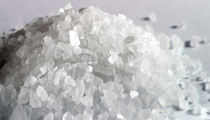
In winter, de-icing salt is used primarily to ensure the safety of use of snow covered or frozen roads and so to improve the flow of transportation.
De-icing salt is a particularly effective mixture of fine and coarse salt grains with an anti-caking product (usually ferrocyanide) allowing the salt grains to remain separated from each others during prolonged storage.
The grain size of the salt used for de-icing is well studied for the specific winter conditions encountered. Thus, while fine grains provide immediate snow melting effect, larger grains guarantee a long-term effect required for thick layers of ice and snow.
Salt Type
|
Origin |
Ferrocyanide |
Method of analysis |
| Washed Salt |
Tunisia |
75 – 100 ppm |
ASTM E534-98 |
| TYPICAL VALUES CHIMICAL DATA |
| Sodium Chloride(NaCl) |
Calcium (Ca) |
Magnesium (Mg) |
Sulfate (SO4) |
Water (H2O) |
Insolubles |
| 98 to 99.4% |
0.01 to 0.2% |
0.1 to 0.3% |
0.3 to 0.8% |
2 to 3% |
0.1 to 0.2% |
Salt Type
|
Origin |
Ferrocyanide |
Method of analysis |
| Unwashed Salt |
Tunisia |
75 – 100 ppm |
ASTM E534-98 |
| TYPICAL VALUES CHIMICAL DATA |
| Sodium Chloride(NaCl) |
Calcium (Ca) |
Magnesium (Mg) |
Sulfate (SO4) |
Water (H2O) |
Insolubles |
| 97.2 to 98.5% |
0.01 to 0.3% |
0.2 to 0.4% |
0.5 to 1% |
2 to 3% |
0.1 to 0.4% |
| TYPICAL VALUES PHYSICAL DATA |
| Boiling point |
Melting point |
PH of solution |
| 1413°C |
802°C |
7 |